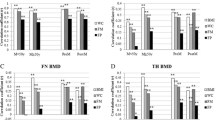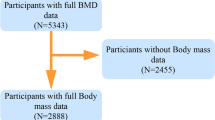Abstract
The effects of total fat mass (FM) and total lean mass (LM) on total bone mineral density (BMD) were examined using the Fourth Korea National Health and Nutrition Examination Survey, 2009. FM, LM, and BMD were measured by DXA in a population-based sample of 6,762 Koreans, aged 19–93 (1,613 men <50 years, 1,400 men ≥50 years, 2,120 premenopausal women, and 1,629 postmenopausal women). After adjusting for confounders (age, height, education, economic status, physical activity, smoking, alcohol use, serum vitamin D, medical history [diabetes, dyslipidemia, rheumatoid arthritis, and osteoporosis], family history of osteoporosis, multivitamin use, dietary intake [energy, calcium, and sodium], age at menarche, age at menopause, and hormone replacement therapy) and FM, higher LM was associated with a lower odds ratio for being in the group-specific lowest quintile of BMD (low BMD) in all groups. The odds for low BMD increased with higher FM in multivariate-adjusted analyses in men <50 years, but this was not significant in other groups. Total BMD decreased with a decrease in the LM quintile across all FM subgroups in men of all ages, in the lower two subgroups of FM quintile in premenopausal women, and in the middle subgroup of FM quintile in postmenopausal women. In conclusion, higher LM was associated with a lower risk of low BMD in both genders, while higher FM was associated with a higher risk of low BMD for men <50 years but not for women and men ≥50 years. The combined effects of LM and FM on BMD were gender- and menopause status–specific.

Similar content being viewed by others
References
Bates DW, Black DM, Cummings SR (2002) Clinical use of bone densitometry: clinical applications. JAMA 288:1898–1900
Nelson HD, Haney EM, Dana T, Bougatsos C, Chou R (2010) Screening for osteoporosis: an update for the U.S. Preventive Services Task Force. Ann Intern Med 153:99–111
Cui L-H, Shin M-H, Kweon S–S, Park K-S, Lee Y-H, Chung E-K, Nam H-S, Choi J-S (2007) Relative contribution of body composition to bone mineral density at different sites in men and women of South Korea. J Bone Miner Metab 25:165–171
Douchi T, Kuwahata R, Matsuo T, Uto H, Oki T, Nagata Y (2003) Relative contribution of lean and fat mass component to bone mineral density in males. J Bone Miner Metab 21:17–21
Langendonck LV, Claessens AL, Lefevre J, Thomis M, Philippaerts R, Delvaux K, Lysens R, Eynde BV, Beunen G (2002) Association between bone mineral density (DXA), body structure, and body composition in middle-aged men. Am J Hum Biol 14:735–742
Kim T, Sung J, Song YM, Lee K, Cho SI (2011) Sex difference between body composition and weight-bearing bone mineral density in Korean adult twins: healthy twin study. Calcif Tissue Int 88:495–502
Lim S, Joung H, Shin CS, Lee HK, Kim KS, Shin EK, Kim HY, Lim MK, Cho SI (2004) Body composition changes with age have gender-specific impacts on bone mineral density. Bone 35:792–798
Reid IR, Plank LD, Evans MC (1992) Fat mass is an important determinant of whole body bone density in premenopausal women but not in men. J Clin Endocrinol Metab 75:779–782
Fu X, Ma X, Lu H, He W, Wang Z, Zhu S (2011) Associations of fat mass and fat distribution with bone mineral density in pre- and postmenopausal Chinese women. Osteoporosis Int 22:113–119
Bhupathiraju SN, Dawson-Hughes B, Hannan MT, Lichtenstein AH, Tucker KL (2011) Centrally located body fat is associated with lower bone mineral density in older Puerto Rican adults. Am J Clin Nutr 94:1063–1070
Li S, Wagner R, Holm K, Lehotsky J, Zinaman MJ (2004) Relationship between soft tissue body composition and bone mass in perimenopausal women. Maturitas 47:99–105
Makovey J, Naganathan V, Sambrook P (2005) Gender differences in relationships between body composition components, their distribution and bone mineral density: a cross-sectional opposite sex twin study. Osteoporos Int 16:1495–1505
Reid I (2008) Relationships between fat and bone. Osteoporos Int 19:595–606
Chen Z, Lohman TG, Stini WA, Ritenbaugh C, Aickin M (1997) Fat or lean tissue mass: which one is the major determinant of bone mineral mass in healthy postmenopausal women? J Bone Miner Res 12:144–151
Gillette-Guyonnet S, Nourhashemi F, Lauque S, Grandjean H, Vellas B (2000) Body composition and osteoporosis in elderly women. Gerontology 46:189–193
Gjesdal CG, Halse JI, Eide GE, Brun JG, Tell GS (2008) Impact of lean mass and fat mass on bone mineral density: the Hordaland Health Study. Maturitas 59:191–200
Coin A, Sergi G, Benincà P, Lupoli L, Cinti G, Ferrara L, Benedetti G, Tomasi G, Pisent C, Enzi G (2000) Bone mineral density and body composition in underweight and normal elderly subjects. Osteoporos Int 11:1043–1050
Wang MC, Bachrach LK, Van Loan M, Hudes M, Flegal KM, Crawford PB (2005) The relative contributions of lean tissue mass and fat mass to bone density in young women. Bone 37:474–481
Center for Disease Control. Education and quality control of bone mineral density in the Fourth National Healthy and Nutition Examination Survey (KNHANES IV-3), 2009. CDC, Osong, Chungcheong Buk-Do, Republic of Korea
Frost HM (1997) On our age-related bone loss: insights from a new paradigm. J Bone Miner Res 12:1539–1546
Laskey MA, Lyttle KD, Flaxman ME, Barber RW (1992) The influence of tissue depth and composition on the performance of the Lunar dual-energy X-ray absorptiometer whole-body scanning mode. Eur J Clin Nutr 46:39–45
Sopher AB, Thornton JC, Wang J, Pierson RN Jr, Heymsfield SB, Horlick M (2004) Measurement of percentage of body fat in 411 children and adolescents: a comparison of dual-energy X-ray absorptiometry with a four-compartment model. Pediatrics 113:1285–1290
Acknowledgements
This work was supported by a grant from Inje University, 2011.
Author information
Authors and Affiliations
Corresponding author
Additional information
The author has stated that there is no conflict of interest.
Rights and permissions
About this article
Cite this article
Lee, K. Soft Tissue Composition and the Risk of Low Bone Mineral Density: The Fourth Korea National Health and Nutrition Examination Survey (KNHANES IV-3), 2009. Calcif Tissue Int 90, 186–192 (2012). https://doi.org/10.1007/s00223-012-9573-x
Received:
Accepted:
Published:
Issue Date:
DOI: https://doi.org/10.1007/s00223-012-9573-x




